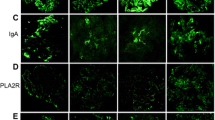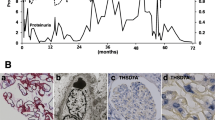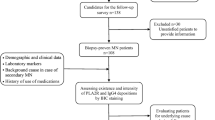Abstract
Background
The clinicopathological features of malignancy-associated membranous nephropathy have been described previously, but information about diagnosis and treatment remains limited.
Methods
Patients with malignancy-associated membranous nephropathy in a tertiary hospital in China between June 2012 and October 2021 were retrospectively reviewed.
Results
Forty-two patients with malignancy-associated membranous nephropathy were identified. Compared to patients with idiopathic membranous nephropathy, patients with malignancy-associated membranous nephropathy were older and less frequently showed glomerular phospholipase A2 receptor staining (37.9% vs 85.0%) and IgG4 predominant deposition (66.7% vs 95.0%). At diagnosis of membranous nephropathy, the malignancy was unknown in 67% (28/42) of patients and was detected only by tumor screening. Among the 19 patients with concurrent diagnosis of cancer and biopsy-proven membranous nephropathy, 15 received anticancer treatment alone initially. Six of the 10 patients who attained cancer remission achieved remission of membranous nephropathy, while none of the 5 patients without remission of cancer did, suggesting a causal relationship between the two diseases. Some patients with persistent or relapsing membranous nephropathy following cancer remission achieved remission of membranous nephropathy after immunosuppressive therapy. Over a median follow-up of 24 months, 25% (10/40) of patients died, mainly due to neoplasia.
Conclusions
Tumor screening is important in patients with membranous nephropathy, especially in elderly patients and patients with negative phospholipase A2 receptor or non-IgG4 predominant deposition. Remission of membranous nephropathy can be observed following remission of cancer in some cases. Immunosuppressive therapy may be considered if membranous nephropathy does not remit after remission of cancer.
Graphical abstract



Similar content being viewed by others
Availability of data and material
The data in the current study are available from the corresponding author on reasonable request.
References
Lee JC, Yamauchi H, Hopper J Jr (1966) The association of cancer and the nephrotic syndrome. Ann Intern Med 64:41–51
Lefaucheur C, Stengel B, Nochy D et al (2006) Membranous nephropathy and cancer: epidemiologic evidence and determinants of high-risk cancer association. Kidney Int 70(8):1510–1517
Leeaphorn N, Kue-A-Pai P, Thamcharoen N et al (2014) Prevalence of cancer in membranous nephropathy: a systematic review and meta-analysis of observational studies. Am J Nephrol 40(1):29–35
Hoxha E, Wiech T, Stahl PR et al (2016) A mechanism for cancer-associated membranous nephropathy. N Engl J Med 374(20):1995–1996
Bjørneklett R, Vikse BE, Svarstad E et al (2007) Long-term risk of cancer in membranous nephropathy patients. Am J Kidney Dis 50(3):396–403
Zhang C, Zhang M, Chen D et al (2019) Features of phospholipase A2 receptor and thrombospondin type-1 domain-containing 7A in malignancy-associated membranous nephropathy. J Clin Pathol 72(10):705–711
Murtas C, Ghiggeri GM (2016) Membranous glomerulonephritis: histological and serological features to differentiate cancer-related and non-related forms. J Nephrol 29(4):469–478
Radice A, Pieruzzi F, Trezzi B et al (2018) Diagnostic specificity of autoantibodies to M-type phospholipase A2 receptor (PLA2R) in differentiating idiopathic membranous nephropathy (IMN) from secondary forms and other glomerular diseases. J Nephrol 31(2):271–278
Cui HY, Li C, Li H et al (2021) Analysis of glomerular IgG subclasses switch in idiopathic membranous nephropathy classified by glomerular phospholipase A2 receptor antigen and serum antibody. Dis Markers 2021:9965343
Huang CC, Lehman A, Albawardi A et al (2013) IgG subclass staining in renal biopsies with membranous glomerulonephritis indicates subclass switch during disease progression. Mod Pathol 26(6):799–805
Qin HZ, Zhang MC, Le WB et al (2016) Combined assessment of phospholipase A2 receptor autoantibodies and glomerular deposits in membranous nephropathy. J Am Soc Nephrol 27:3195–3203
Tomas NM, Beck LH, Meyer-Schwesinger C et al (2014) Thrombospondin type-1 domain-containing 7A in idiopathic membranous nephropathy. N Engl J Med 371:2277–2287
Larsen CP, Messias NC, Silva FG et al (2013) Determination of primary versus secondary membranous glomerulopathy utilizing phospholipase A2 receptor staining in renal biopsies. Mod Pathol 26(5):709–715
Lönnbro-Widgren J, Ebefors K, Mölne J et al (2015) Glomerular IgG subclasses in idiopathic and malignancy-associated membranous nephropathy. Clin Kidney J 8(4):433–439
Timmermans SA, Ayalon R, van Paassen P et al (2013) Anti-phospholipase A2 receptor antibodies and malignancy in membranous nephropathy. Am J Kidney Dis 62(6):1223–1225
Ohtani H, Wakui H, Komatsuda A et al (2004) Distribution of glomerular IgG subclass deposits in malignancy-associated membranous nephropathy. Nephrol Dial Transplant 19(3):574–579
Qu Z, Liu G, Li J et al (2012) Absence of glomerular IgG4 deposition in patients with membranous nephropathy may indicate malignancy. Nephrol Dial Transplant 27(5):1931–1937
Hoxha E, Beck LH Jr, Wiech T et al (2017) An indirect immunofluorescence method facilitates detection of thrombospondin type 1 domain-containing 7A-specific antibodies in membranous nephropathy. J Am Soc Nephrol 28(2):520–531
Wang J, Cui Z, Lu J et al (2017) Circulating antibodies against thrombospondin type-I domain-containing 7A in Chinese patients with idiopathic membranous nephropathy. Clin J Am Soc Nephrol 12(10):1642–1651
Sharma SG, Larsen CP (2018) Tissue staining for THSD7A in glomeruli correlates with serum antibodies in primary membranous nephropathy: a clinicopathological study. Mod Pathol 31(4):616–622
Zaghrini C, Seitz-Polski B, Justino J et al (2019) Novel ELISA for thrombospondin type 1 domain-containing 7A autoantibodies in membranous nephropathy. Kidney Int 95(3):666–679
Funding
This work was supported by the National Natural Sciences Foundation of China Grants (81970621 to Dr. Qin).
Author information
Authors and Affiliations
Corresponding author
Ethics declarations
Conflict of interest
The authors declare that they have no conflict of interest.
Ethical approval
The study was approved by the Institutional Review Board of Peking Union Medical College Hospital (S-K2073). Patient data were anonymously used under consideration of the latest version of the Helsinki Declaration of human research ethics.
Informed consent
Informed consent was obtained from all participating patients.
Additional information
Publisher's Note
Springer Nature remains neutral with regard to jurisdictional claims in published maps and institutional affiliations.
Supplementary Information
Below is the link to the electronic supplementary material.

40620_2023_1751_MOESM1_ESM.jpg
Supplementary file1 Fig. S1. Treatment and outcome of the 6 patients with simultaneous diagnosis of cancer and MN (not biopsy-proven). IST indicates immunosuppressive therapy. (JPG 133 KB)

40620_2023_1751_MOESM2_ESM.jpg
Supplementary file2 Fig. S2. Treatment and outcome of the 4 patients with cancer discovered after the diagnosis of MN (not biopsy-proven). IST indicates immunosuppressive therapy. (JPG 138 KB)
Rights and permissions
Springer Nature or its licensor (e.g. a society or other partner) holds exclusive rights to this article under a publishing agreement with the author(s) or other rightsholder(s); author self-archiving of the accepted manuscript version of this article is solely governed by the terms of such publishing agreement and applicable law.
About this article
Cite this article
Ai, S., Yan, X., Zhao, X. et al. Malignancy-associated membranous nephropathy: focus on diagnosis and treatment. J Nephrol 36, 2355–2363 (2023). https://doi.org/10.1007/s40620-023-01751-4
Received:
Accepted:
Published:
Issue Date:
DOI: https://doi.org/10.1007/s40620-023-01751-4




